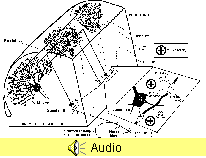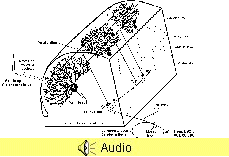Circuitry
Folia
 Now, what about
branches of the DSCT, CCT, VCT and
PCT that are destined for the cerebellar cortex. The
axons of these inputs are called MOSSY fibers. Like
climbing fibers, the information carried by mossy fibers is
heading for the Purkinje cells. However, unlike climbing
fibers, mossy fibers DO NOT go directly to the
Purkinje cell. Each mossy fiber branches profusely in the
white matter. Each of these branches has multiple (up to 50)
swellings (that resembled moss to the old time
neuroanatomists) that contain round vesicles and synaptic
thickenings. Each swelling, called a "rosette", is a synapse
of the mossy fiber onto the dendrite of a granule cell. In
the detail above you can see two rosettes contacting two
different dendrites of the same granule cell. These are
excitatory synapses. A rosette can also occur where the
dendrites of several (up to 15) granule cells are contacted.
Each mossy fiber can have up to 50 rosettes. You can see
that there is considerable divergence of the mossy fiber
signal.
Now, what about
branches of the DSCT, CCT, VCT and
PCT that are destined for the cerebellar cortex. The
axons of these inputs are called MOSSY fibers. Like
climbing fibers, the information carried by mossy fibers is
heading for the Purkinje cells. However, unlike climbing
fibers, mossy fibers DO NOT go directly to the
Purkinje cell. Each mossy fiber branches profusely in the
white matter. Each of these branches has multiple (up to 50)
swellings (that resembled moss to the old time
neuroanatomists) that contain round vesicles and synaptic
thickenings. Each swelling, called a "rosette", is a synapse
of the mossy fiber onto the dendrite of a granule cell. In
the detail above you can see two rosettes contacting two
different dendrites of the same granule cell. These are
excitatory synapses. A rosette can also occur where the
dendrites of several (up to 15) granule cells are contacted.
Each mossy fiber can have up to 50 rosettes. You can see
that there is considerable divergence of the mossy fiber
signal.
 Granule cells have long
axons that pass dorsally through the granule and Purkinje,
cell layers to reach the molecular layer of the
cerebellar cortex, where they bifurcate and run
PARALLEL to the long axis of the folium. These
fibers, which are called parallel fibers, travel at
right angles to the dendrites of the Purkinje cells
(think of telephone lines running through a row of
(flattened) trees in the fall after peak color). Each
parallel fiber synapses upon and excites the
dendritic spines of numerous Purkinje cells, but the
synaptic effect of a single parallel fiber upon a
Purkinje cell is extremely weak (contrast this with a
climbing fiber). How then can the mossy fiber input fire the
Purkinje cells? Well, what is needed is for many mossy
fibers to fire rapidly and together, which causes many
granule cells to fire together, which turns on lots
of parallel fibers which then excite enough of the spines on
a Purkinje cell to result in an action potential. When this
occurs, the Purkinje cell exhibits what is called a
simple spike. Such a spike in a Purkinje cell is
shown below. In contrast to those lazy climbing fibers that
fire about 1 per second (yet have a very powerful effect
upon the Purkinje cell resulting in the complex
spike), mossy fibers are really "gunners" (I use the
term affectionately) in that they are always working. Thus
they fire spontaneously and rapidly (50-100 per second) and
cause (via the granule cells and parallel fibers of course)
Purkinje cells to fire simple spikes at the same
frequency.
Granule cells have long
axons that pass dorsally through the granule and Purkinje,
cell layers to reach the molecular layer of the
cerebellar cortex, where they bifurcate and run
PARALLEL to the long axis of the folium. These
fibers, which are called parallel fibers, travel at
right angles to the dendrites of the Purkinje cells
(think of telephone lines running through a row of
(flattened) trees in the fall after peak color). Each
parallel fiber synapses upon and excites the
dendritic spines of numerous Purkinje cells, but the
synaptic effect of a single parallel fiber upon a
Purkinje cell is extremely weak (contrast this with a
climbing fiber). How then can the mossy fiber input fire the
Purkinje cells? Well, what is needed is for many mossy
fibers to fire rapidly and together, which causes many
granule cells to fire together, which turns on lots
of parallel fibers which then excite enough of the spines on
a Purkinje cell to result in an action potential. When this
occurs, the Purkinje cell exhibits what is called a
simple spike. Such a spike in a Purkinje cell is
shown below. In contrast to those lazy climbing fibers that
fire about 1 per second (yet have a very powerful effect
upon the Purkinje cell resulting in the complex
spike), mossy fibers are really "gunners" (I use the
term affectionately) in that they are always working. Thus
they fire spontaneously and rapidly (50-100 per second) and
cause (via the granule cells and parallel fibers of course)
Purkinje cells to fire simple spikes at the same
frequency.